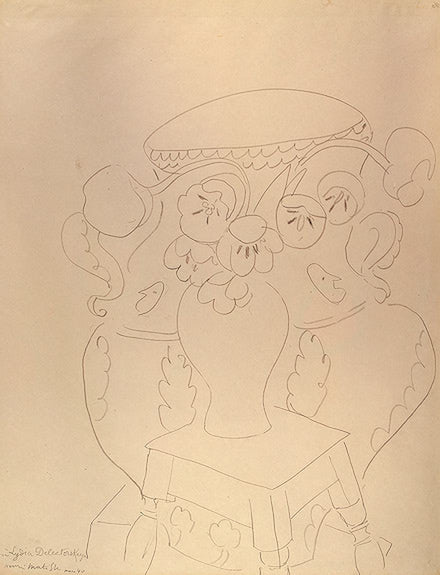Description
Henri Matisse, one of the most prominent figures of modern art, offers in his work "Still Life with Two Vases" from 1940 a sublime example of his mastery in composition and use of color. This still life, painted during a period of great historical turbulence, not only reflects the unease of its time but also Matisse's incessant quest for beauty and serenity.
The painting presents two vases situated on the table, each with a variety of flowers. The arrangement of objects within the pictorial space reveals a deliberately simple yet effective composition in its balance. Matisse plays with curved and straight forms, finding in simplicity a powerful form of expression. The contours are outlined with precision, leaving no room for ambiguity, a typical feature of Matisse's work during this phase of his career.
The use of color is, as in many of his works, masterful. The vivid and contrasting colors stand out exuberantly, with the deep blue of the background creating a tranquil yet profound scene. The vases, each different in shape and color, provide a chromatic variety that brings the image to life. The flowers, painted in warm tones of red, yellow, and orange, emerge with palpable vitality, standing out against the blue background. The handling of color in this work is characteristic of Fauvism, a movement of which Matisse was an undisputed leader, always seeking the most intense and direct expression of color.
It is especially notable how Matisse manages to convey a sense of stability and structure through the spatial arrangement of the elements. The two vases and the flowers establish a visual triangle that gently guides the observer's gaze through the painting. This form of composition reveals a depth in planning that may not be evident at first glance but demonstrates the artist's care and skill in balancing each part of his work.
Behind this appearance of simplicity lies a profound understanding of the interaction between forms and spaces. The arrangement of the vases at different levels and their differentiation in color and shape could be interpreted as a metaphor for diversity and complementarity, recurring themes in Matisse's work. This diversity is shown not only in the objects themselves but also in the play of light and shadow, which adds an extra dimension and reinforces the three-dimensionality of the elements.
In the context of art history, "Still Life with Two Vases" is firmly placed within the mature phase of Matisse's work, where his interest in the simplification of forms and the vitality of color reach their maximum expression. This work is not only a reflection of his technical skills but also of his artistic philosophy. Matisse believed that art should be a source of peace and joy, a refuge of tranquility amid the chaos of the world. Through this work, we can feel his desire to find a harmonious balance in the complexity of life.
In summary, "Still Life with Two Vases" is an eloquent and vibrant representation of Henri Matisse's artistic genius. Through its composition, use of color, and delicate handling of form, Matisse offers us a window not only into his vision of the world but also into a profound quest for eternal beauty and harmony.

